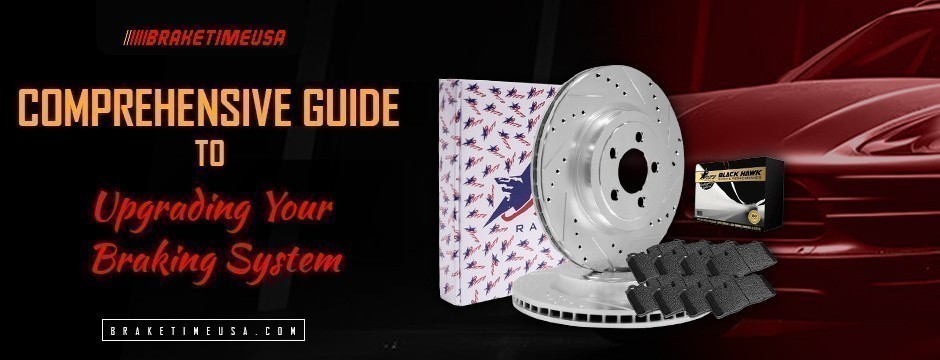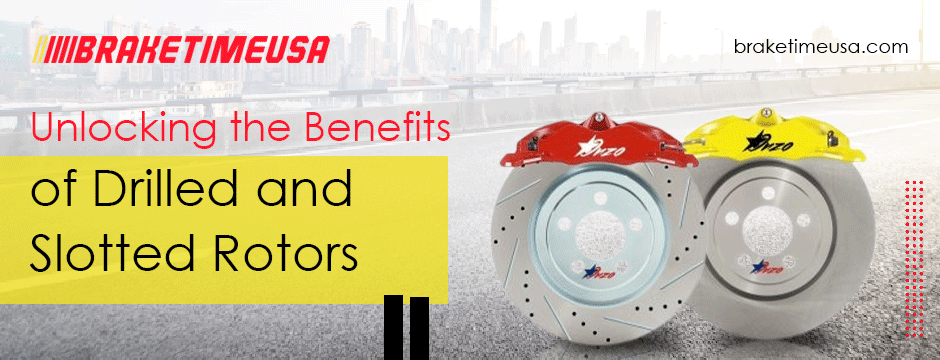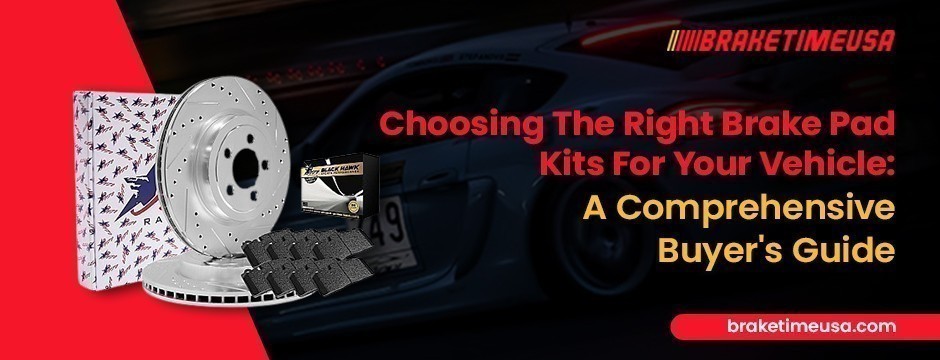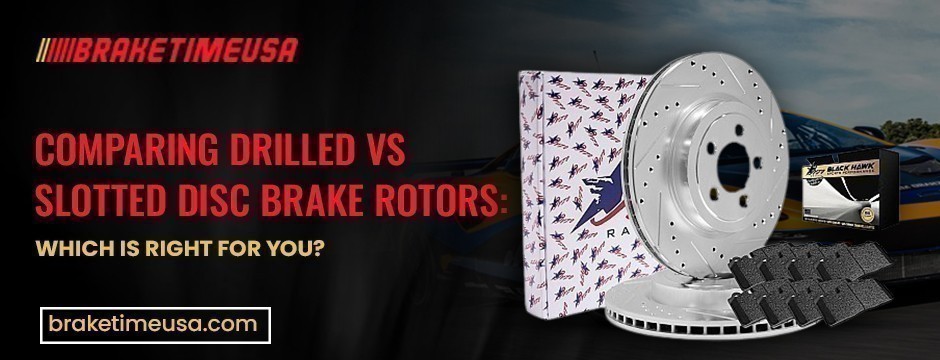Your cart is empty
Subtotal:$0.00
The braking system is a critical component in any vehicle's overall safety and performance. Responsible for slowing down or bringing the vehicle to a complete stop, the braking system ensures driver and passenger safety. Understanding the significance of a well-functioning braking system is foundational to appreciating the need for periodic upgrades.

Upgrading the braking system goes beyond pursuing enhanced performance; it is a crucial investment in safety. An upgraded braking system can provide superior stopping power, reduce braking distances, and enhance overall control, especially in challenging driving conditions. Whether for high-performance driving or everyday commuting, a properly upgraded braking system contributes to the overall driving experience and, more importantly, ensures the safety of both the driver and passengers.
Components (Brake Pads, Rotors, Calipers, Brake Lines): In the conventional braking system, several key components work harmoniously to ensure effective braking.
Brake Pads: These friction materials press against the rotors to generate the necessary stopping force.
Rotors: Commonly known as brake discs, rotors are circular metal discs that rotate with the wheel. Brake pads contact these rotors to create friction and slow down the vehicle.
Calipers: Housed over the rotors, calipers contain the brake pads and facilitate their movement, ensuring proper contact with the rotors.
Brake Lines: These hydraulic lines transmit brake fluid pressure from the master cylinder to the brake calipers, initiating the braking process.
How the Braking System Works:
When the brake pedal is pressed, the master cylinder sends brake fluid through the brake lines to the calipers. The calipers then squeeze the brake pads against the rotating rotors, creating friction that converts kinetic energy into heat, ultimately slowing down the vehicle. This process is fundamental to the safe operation of a vehicle.
Wear and Tear: The friction between brake pads and rotors leads to wear and tear over time. It's crucial to monitor the thickness of the brake pads and the condition of the rotors regularly. Worn-out brake pads can compromise braking efficiency and safety.
Brake Fade: Brake fade occurs when prolonged or aggressive braking causes a significant increase in the temperature of the braking components, leading to a reduction in braking efficiency. Upgrading to heat-resistant materials or improving ventilation can mitigate brake fade.
Reduced Stopping Power: As brake pads wear down or lose their effectiveness, the stopping power of the braking system diminishes. This can result in longer braking distances and increased risks of accidents. Regular inspections and timely replacement of worn components are essential to maintain optimal stopping power.
Overheating: Intense or prolonged braking, such as during downhill descents, can cause the braking system to overheat. Overheating may lead to brake fade and reduce the lifespan of components. Upgrading to high-performance brake materials, improving ventilation, and using larger rotors can help manage overheating issues.
Squeaking or Grinding Noises: Unusual sounds emanating from the braking system, such as squeaking or grinding, indicate potential issues. Squeaking often suggests worn brake pads, while grinding noises may imply metal-on-metal contact, signifying severely worn pads or damaged rotors. These audible cues serve as early warnings, prompting the need for a thorough inspection and, potentially, an upgrade to address the underlying problems.
Vibrations or Pulsations: If you experience vibrations or pulsations through the brake pedal while applying brakes, it may signal uneven wear or warping of the brake rotors. This issue can compromise the smooth operation of the braking system, leading to reduced performance. Addressing these vibrations promptly may involve upgrading to high-quality rotors or ensuring proper alignment of existing components.
Increased Stopping Distances: A noticeable increase in the distance it takes for your vehicle to come to a complete stop is a clear indication of diminished braking efficiency. This can result from worn brake pads, insufficient friction, or deteriorating components. Upgrading to high-performance brake pads and rotors can significantly improve stopping distances, enhancing overall safety.
Dashboard Warning Lights: Modern vehicles have sophisticated onboard diagnostics systems that monitor various aspects, including the braking system. If the system detects abnormalities such as low brake fluid levels or a malfunction in the anti-lock braking system (ABS), it will trigger dashboard warning lights. Ignoring these warning lights can have serious consequences, making it imperative to conduct a comprehensive inspection and consider upgrading relevant components.
These warning signs are crucial for maintaining a safe and effective braking system. Timely upgrades in response to these indicators enhance the braking system's performance and contribute to overall vehicle safety. Regular inspections and proactive measures can prevent potential issues from escalating, ensuring that your braking system remains in optimal condition.
Ceramic Brake Pads: Known for their durability and low noise, ceramic disc brake pads offer excellent heat dissipation, making them suitable for everyday driving. They produce less dust, keeping wheels cleaner.
Semi-Metallic Brake Pads: Comprising a mix of metals and organic materials, semi-metallic pads provide robust stopping power, particularly in high-temperature conditions. They are well-suited for performance-oriented driving.
Organic Brake Pads: Made from non-metallic materials like rubber, glass, and Kevlar, organic pads offer a quieter operation and are environmentally friendly. However, they may wear faster than other types.
Enhanced Stopping Power: Upgraded disc brake pads often deliver superior stopping power, reducing braking distances for improved safety.
Heat Resistance: Performance brake pads are designed to withstand higher temperatures, preventing brake fade during intense or prolonged braking.
Reduced Noise and Dust: Some materials, such as ceramics, contribute to quieter braking and less dust accumulation on wheels.
Ventilated Rotors: Equipped with vanes or fins between the rotor surfaces, ventilated rotors enhance heat dissipation. This design minimizes the risk of overheating during demanding driving conditions.
Solid Rotors: Traditional and cost-effective solid rotors lack the additional ventilation features. They are suitable for standard driving conditions but may be prone to overheating during high-performance use.
Drilled Rotors: Feature holes drilled into the rotor surface to aid in heat dissipation. While visually appealing, they may be prone to cracking under extreme stress.
Slotted Rotors: Contain slots or grooves on the rotor surface, allowing for the expulsion of gases and debris. Slotted rotors are effective in maintaining consistent braking performance.
Performance Calipers: Engineered with improved materials and design, performance calipers provide better heat dissipation and enhanced clamping force. They contribute to more precise braking control and reduced brake fade.
Stock Calipers: Standard calipers with the vehicle are often suitable for regular driving conditions but may lack the performance capabilities required for spirited driving or track use.
Caliper Material: Consider calipers made from materials like aluminum for improved heat dissipation.
Piston Configuration: Opt for calipers with multiple pistons for enhanced braking force distribution.
Improved Durability: Stainless steel brake lines resist corrosion and abrasion, providing durability under various driving conditions.
Enhanced Brake Feel: Braided lines offer a firmer brake pedal feel and improved responsiveness.
Reduced Expansion: Unlike rubber lines, stainless steel lines minimize expansion under pressure, maintaining consistent brake performance.
Professional Installation: Braided brake lines often require professional installation to ensure proper fitting and function.
Regular Inspection: Periodic inspection of braided lines is essential to identify any signs of wear or damage.
Temperature Resistance: Performance brake fluids withstand higher temperatures, reducing the risk of brake fades under demanding conditions.
Hygroscopic Properties: Performance fluids have low moisture absorption, maintaining consistent braking performance over time.
DOT Ratings: Consider the Department of Transportation (DOT) rating suitable for your driving needs.
Fluid Compatibility: Choose a brake fluid compatible with the materials used in your upgraded braking system.
These upgrades collectively contribute to an enhanced braking system, offering improved performance, durability, and safety. Choosing the right combination of components depends on individual driving preferences, conditions, and the desired level of performance.
Mechanical Aptitude: Assess your mechanical proficiency and comfort level with automotive systems. While some brake upgrades may be straightforward, others require a deeper understanding of the braking system's intricacies.
Experience: Consider your experience with DIY automotive projects. You may be well-equipped for certain upgrades if you have completed brake-related tasks, such as changing brake pads or rotors.
Basic Tools: Upgrading brake components may require standard tools like wrenches, sockets, and a jack. Ensure you have the appropriate tools for the specific upgrade you are undertaking.
Specialized Tools: Some upgrades, such as replacing brake lines or calipers, may require specialized tools. Evaluate whether you have access to or are willing to acquire these tools.
Manufacturer Warranty: Professional installations often come with warranties from the service provider. This ensures that any issues arising from faulty installation can be addressed without additional costs to the vehicle owner.
Component Warranties: Many upgraded brake components come with warranties, and professional installation is often a prerequisite for maintaining these warranties. This can provide peace of mind and financial protection in premature component failure.
Expertise: Professional technicians have the expertise and experience to ensure each component is installed correctly. This includes proper torquing, bleeding of brake lines, and addressing any unforeseen challenges during the installation process.
Precision: Brake systems require a high level of precision for optimal performance. Professional installers know to fine-tune the braking system, ensuring it operates efficiently.
Diagnostic Capabilities: Professionals can conduct thorough diagnostics before and after the installation, identifying any pre-existing issues and ensuring that the upgraded components function as intended.
Comprehensive Assessment: Begin by conducting a comprehensive assessment of your budget. Consider how much you are willing to invest in upgrading your braking system.
Prioritization: Prioritize the upgrades based on your driving needs. Identify critical components that require immediate attention and those that can be addressed later.
Research: Research the cost of various brake system components and services. This will provide a realistic understanding of the expenses involved.
Brake Pads: Understand the cost range for different types of brake pads – ceramic, semi-metallic, and organic.
Rotors: Evaluate the prices of both ventilated and solid rotors and the additional costs associated with drilled or slotted options.
Brake Calipers: Consider the price difference between performance and stock calipers, factoring in the material and design aspects.
Brake Lines: Determine the cost of upgrading to braided stainless steel brake lines, accounting for materials and installation.
Brake Fluid: Research the prices of performance brake fluids, considering factors such as brand reputation and compatibility.
Upfront Costs: Acknowledge the initial investment required for brake system upgrades. This includes the cost of components, professional installation, and specialized tools.
Long-term Savings: Consider the potential long-term savings associated with upgraded components. Components with extended lifespan and improved performance may reduce maintenance costs over the vehicle's lifetime.
Enhanced Safety: Factor in the value of enhanced safety provided by the upgraded braking system. Improved stopping power and reliability contribute to accident prevention and overall driver safety.
Visual Inspection: Regularly inspect the brake components for signs of wear, such as thinning brake pads or uneven rotor surfaces.
Listen for Anomalies: Pay attention to any unusual sounds during braking, as these may indicate potential issues.
Check for Leaks: Inspect brake lines for any signs of leaks or damage.
Caliper Maintenance: Keep calipers clean and debris-free—Lubricate caliper slide pins to ensure smooth movement.
Rotor Care: Clean rotors periodically to prevent brake dust buildup. Lubricate areas where the brake pads contact the calipers for optimal performance.
Regular Checks: Monitor brake fluid levels regularly and top up as needed. Ensure that the brake fluid is within the recommended range.
Fluid Quality: Periodically check the quality of the brake fluid. If it appears discolored or contaminated, consider flushing the brake fluid system.
By incorporating these maintenance tips into your routine, you can ensure your upgraded braking system's longevity and optimal performance. Regular inspections and proactive care will contribute to a safer driving experience and extend the lifespan of your investment in high-performance brake components.
Inconsistent Components: Consider their compatibility before upgrading individual components. A balanced upgrade ensures all components work seamlessly together, preventing issues like uneven wear or reduced performance.
Ignoring System Integration: Failing to consider how upgraded brake pads, rotors, calipers, and other components work together may lead to suboptimal performance. Prioritize a holistic approach to achieve the desired results.
Assuming Upgrades Are Maintenance-Free: Even with high-performance upgrades, regular maintenance is crucial. Neglecting routine checks can lead to premature wear, reduced efficiency, and potential safety hazards.
Ignoring Warning Signs: Do not ignore signs of wear or performance issues. Addressing concerns promptly can prevent further damage and costly repairs.
Lack of Expert Guidance: Consult a professional before proceeding with upgrades. Expert advice ensures that you choose the right components based on your driving needs and vehicle specifications.
Missing Out on Recommendations: Professionals can offer valuable insights into the best practices for installation, potential compatibility issues, and tips for maximizing the benefits of upgrades.
Regenerative Braking: Explore the growing trend of regenerative braking systems that capture and store energy during braking, potentially increasing fuel efficiency in hybrid and electric vehicles.
Advanced Materials: Look into the development of advanced brake materials, such as carbon-ceramic composites, offering improved performance, reduced weight, and enhanced durability.
Electronic Braking Systems: Understand the evolution of electronic braking systems that integrate sensors and smart technologies to optimize real-time braking performance.
Increased Efficiency: Future braking systems may prioritize efficiency, providing shorter braking distances and improved response times.
Integration with Vehicle Systems: Advancements in technology may lead to greater integration between braking and other vehicle systems, enhancing overall safety and performance.
Smart Maintenance Systems: Explore the possibility of smart maintenance systems that use predictive analytics to anticipate component wear, reducing the need for reactive repairs.
As the automotive industry evolves, staying informed about emerging technologies is essential for deciding on brake system upgrades. Embracing these advancements ensures that your vehicle remains at the forefront of safety, efficiency, and performance.
A well-maintained and upgraded braking system is a fundamental aspect of vehicle safety, directly impacting your ability to control and stop your vehicle. Regular inspections, maintenance routines, and timely upgrades enhance performance and contribute to your vehicle's longevity. As technology evolves, staying informed about advancements ensures that your braking system remains aligned with the latest safety standards and innovations.
A conscientious approach to maintaining and upgrading your braking system is an investment in your vehicle's safety, performance, and overall longevity. By staying informed, making responsible decisions, and prioritizing regular maintenance, you contribute to a safer driving environment for yourself and others on the road. Remember, a well-maintained braking system is not just a feature; it's a commitment to responsible and enjoyable driving.
Want to find out more? Visit us at Braketime!
 Mar 27, 2024Unlocking the Benefits of Drilled and Slotted Rotors
Mar 27, 2024Unlocking the Benefits of Drilled and Slotted Rotors Mar 22, 2024Choosing The Right Brake Pad Kits For Your Vehicle: A Comprehensive Buyer's Guide
Mar 22, 2024Choosing The Right Brake Pad Kits For Your Vehicle: A Comprehensive Buyer's Guide Mar 18, 2024Exploring Different Types of Rear Brake Rotors
Mar 18, 2024Exploring Different Types of Rear Brake Rotors Mar 6, 2024Comparing Drilled vs. Slotted Disc Brake Rotors: Which Is Right for You?
Mar 6, 2024Comparing Drilled vs. Slotted Disc Brake Rotors: Which Is Right for You?
 Feb 5, 2024Comprehensive Guide on How To Check Brake Pads and Rotors for Optimal Maintenance
Feb 5, 2024Comprehensive Guide on How To Check Brake Pads and Rotors for Optimal Maintenance© 2023 - 2024 Braketimeusa. All rights reserved.
